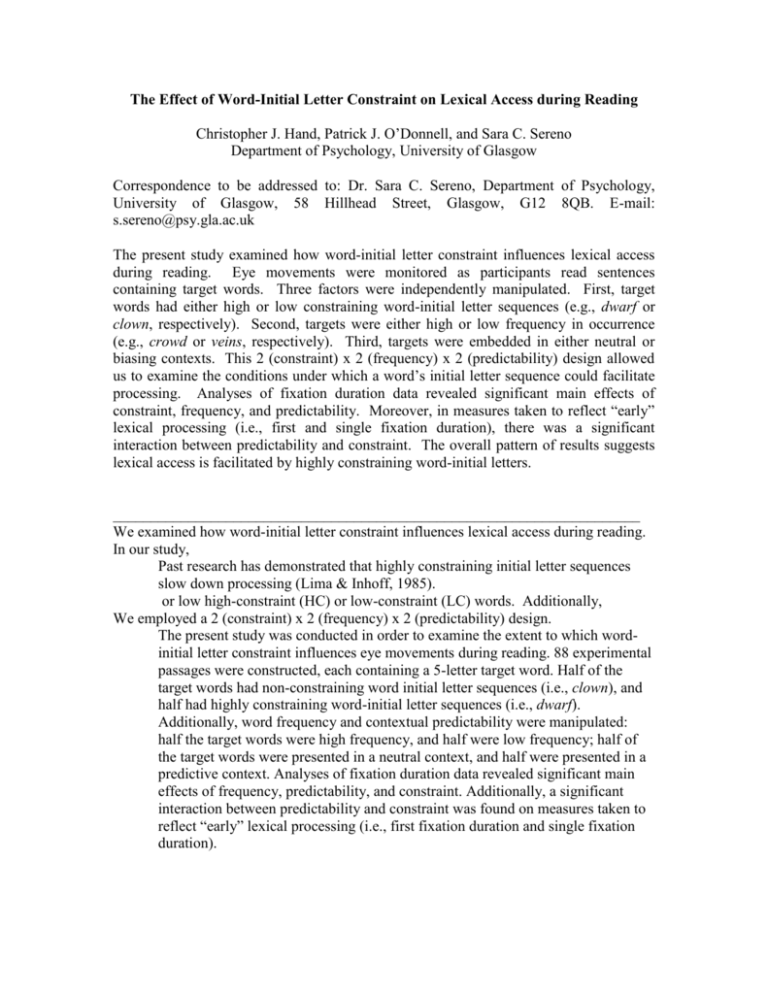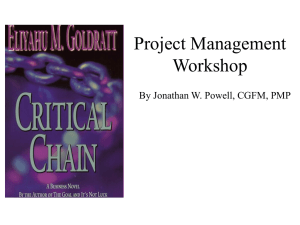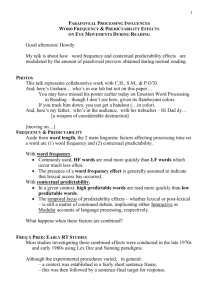Clown-dwarf_abstract_v2_2008 - Psychology
advertisement

The Effect of Word-Initial Letter Constraint on Lexical Access during Reading Christopher J. Hand, Patrick J. O’Donnell, and Sara C. Sereno Department of Psychology, University of Glasgow Correspondence to be addressed to: Dr. Sara C. Sereno, Department of Psychology, University of Glasgow, 58 Hillhead Street, Glasgow, G12 8QB. E-mail: s.sereno@psy.gla.ac.uk The present study examined how word-initial letter constraint influences lexical access during reading. Eye movements were monitored as participants read sentences containing target words. Three factors were independently manipulated. First, target words had either high or low constraining word-initial letter sequences (e.g., dwarf or clown, respectively). Second, targets were either high or low frequency in occurrence (e.g., crowd or veins, respectively). Third, targets were embedded in either neutral or biasing contexts. This 2 (constraint) x 2 (frequency) x 2 (predictability) design allowed us to examine the conditions under which a word’s initial letter sequence could facilitate processing. Analyses of fixation duration data revealed significant main effects of constraint, frequency, and predictability. Moreover, in measures taken to reflect “early” lexical processing (i.e., first and single fixation duration), there was a significant interaction between predictability and constraint. The overall pattern of results suggests lexical access is facilitated by highly constraining word-initial letters. ______________________________________________________________________ We examined how word-initial letter constraint influences lexical access during reading. In our study, Past research has demonstrated that highly constraining initial letter sequences slow down processing (Lima & Inhoff, 1985). or low high-constraint (HC) or low-constraint (LC) words. Additionally, We employed a 2 (constraint) x 2 (frequency) x 2 (predictability) design. The present study was conducted in order to examine the extent to which wordinitial letter constraint influences eye movements during reading. 88 experimental passages were constructed, each containing a 5-letter target word. Half of the target words had non-constraining word initial letter sequences (i.e., clown), and half had highly constraining word-initial letter sequences (i.e., dwarf). Additionally, word frequency and contextual predictability were manipulated: half the target words were high frequency, and half were low frequency; half of the target words were presented in a neutral context, and half were presented in a predictive context. Analyses of fixation duration data revealed significant main effects of frequency, predictability, and constraint. Additionally, a significant interaction between predictability and constraint was found on measures taken to reflect “early” lexical processing (i.e., first fixation duration and single fixation duration).









